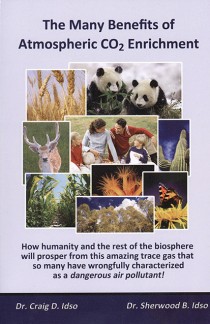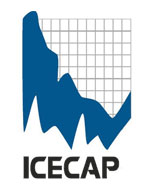SPPI has published a new Book, The Many Benefits of Atmospheric CO2 Enrichment. The full book can be purchased here.
Global warming alarmists tell us the horrors of increasing atmospheric CO2 concentration. Skeptics tell us that it’s not all that bad. Finally, there is a non-apologetic treatise that tells us of the benefits of atmospheric CO2 enrichment in an alphabetical format. This extensively referenced 360-page color book by Drs. Idso and Idso tells us of fifty-five benefits of atmospheric CO2 enrichment, and belongs in the library of all who study CO2 and climate.
That’s 55 benefits. Fifty-five!
The benefits are not squeezed out of computer models, but are based on real data. CO2, after all, is plant food, absolutely necessary for all of the biosphere.
The Science and Public Policy Institute has released a ground-breaking book chronicling the many benefits of atmospheric CO2 concentrations. The 55 benefits discussed are drawn exclusively on the peer-reviewed literature.

Many books and reports rail against mankind’s usage of fossil fuels such as coal, gas and oil because of the carbon dioxide or CO2 that their combustion releases into the atmosphere.
Indeed, this phenomenon is routinely castigated in numerous print and visual venues as a result of the unproven predictions of catastrophic CO2-induced global warming that are derived from theoretical computer-driven simulations of the state of earth’s climate decades and centuries into the future.
Now, however, comes a book that does just the opposite by describing a host of real-world benefits that the controversial atmospheric trace gas provides, first to earth’s plants and then to the people and animals that depend upon them for their sustenance.
The book is The Many Benefits of Atmospheric CO2 Enrichment, written by the son/father team of Craig D. and Sherwood B. Idso. It is encyclopedic in nature, with fifty-five different subjects treated and arranged in alphabetical order—starting with Air Pollution Stress (Non-Ozone) and ending with Wood Density—each of which entries comes with its own set of reference citations.
The book is subtitled How humanity and the rest of the biosphere will prosper from this amazing trace gas that so many have wrongfully characterized as a dangerous air pollutant.
Says Dr. Craig Idso, “It may not be everything you ‘always wanted to know’ about the bright side of the issue; but it illuminates a number of significant aspects of earth’s biosphere and its workings, as well as mankind’s reliance on the biosphere for food and numerous other material necessities that are hardly ever mentioned by the UN IPCC or the mainstream media.”
The book is so unique a reference source that it belongs in the library of every organization or institution concerned about the issues of CO2 enhancement and derived public policy initiatives.
Brief synopses of each of the 55 sections of the book may be found on the SPPI [scienceandpublicpolicy.org] website and that of the Center for the Study of Carbon Dioxide and Global Change at www.co2science.org
The book can be ordered from Vales Lake Press.
Contacts: Robert Ferguson or Dr. Craig Idso
cidso@co2science.org
bferguson@sppinstitute.org
www.scienceandpublicpolicy.org
Washington - This morning, EPA Administrator Lisa Jackson will appear before the House Subcommittee on Energy and Power to defend her agency’s attempted takeover of greenhouse gas regulation. In anticipation, the Institute for Energy Research puts forward its own quesitons for Ms. Jackson to consider.
1. The point of EPA regulating greenhouse gas regulations is to reduce global warming. The Waxman-Markey bill, which would have forced an 83 percent reduction in greenhouse gases by 2050 would have reduced global temperatures by 0.05C by 2050 and 0.112C by 2100. How many hundredths of a degree Celsius of warming will EPA’s greenhouse gas regulations avert?
2. You have called these carbon dioxide regulations “common sense” regulation. Is it common sense regulation to impose billions of dollars in costs on the American people when the benefits of the regulations are a few hundredths of a degree less temperature increase?
3. The United States is the world’s third largest oil producer, the world’s largest natural gas producer, and the world’s second largest coal producer. EPA’s regulations will increase the prices and costs of using all of these resources. Why does EPA want to increase the prices of these key resources when the regulations won’t have a noticeable impact on global warming?
4. According to data from the Global Carbon Project, from 1999 to 2009, China’s CO2 emissions increased by 126%, India’s CO2 emissions increased by 63%, Brazil’s CO2 emissions increased 16%, and South Korea’s CO2 emissions increased by 30%. By contrast, America’s CO2 emissions decreased by 5%. What value does the administration see in reducing carbon dioxide emissions when our emissions have decreased while others countries’ emissions are dramatically increasing?
5. If EPA further regulates new sulfur dioxide, nitrogen oxide, particulate, mercury, and other harmful emissions, it could cost $180 billion in compliance costs - and that’s before carbon dioxide regulations. What others steps has EPA taken to achieve the President’s goal of making electricity prices “necessarily skyrocket” in order to reduce carbon dioxide emissions?
6. The recessions significantly contributed to a reduction in U.S. CO2 emissions. Your “common sense” plan is to reduce CO2 emissions. Does this mean that a recession is a common sense way to reduce our CO2 emissions?
7. How many additional deaths may occur in traffic accidents because EPA’s greenhouse gas regulations will force people to buy smaller, more fuel efficient cars?
8. Studies have found that increased energy prices harm human health because people are forced to spend money on higher energy bills instead of for better health. One study found that replacing 3/4 of U.S. coal-based electricity with higher priced electricity, such as that from renewables, will lead to 150,000 premature deaths. (See Harvey Brenner, Health Benefits of Low Cost Energy: An Econometric Case Study, Environmental Manager, and November 2005). How does EPA assess the harm to human health caused by higher energy prices and more regulations?
9. Are Americans just not smart enough to drive the “right” vehicles or use the “right” sources of energy? In 2010, SUV sales were up 21%, midsize car sales were up 7.8%, but EPA’s preferred high-mileage hybrids were down 8.1% and compact cars are up just 1.1%. See.
10. Who makes better decisions about how my family uses energy—EPA officials or my family?
Extra Credit Question:
In the documentation accompanying EPA’s vehicle greenhouse gas emission regulations, it states that EPA’s regulations will lead to a reduction in global temperature by “0.006 to 0.0015C by 2100” and “sea-level rise is projected to be reduced by approximately 0.06cm-0.14cm by 2100.” Will EPA’s regulation of large emitters of carbon dioxide result in global temperature reduction more or less than 0.0015C?
Institute for Energy Research | 1100 H Street, NW | Suite 400 | Washington, DC 20005
See also Senator Inhofe opening statement in committee on the EPA’s planned regulation.
See also Congressional Energy and Environmental Policy Leaders Filed an Amicus Brief with the supreme court.


